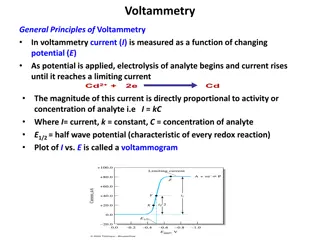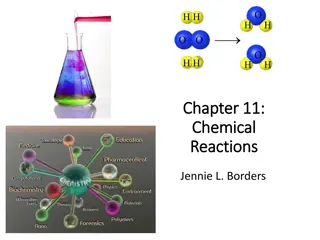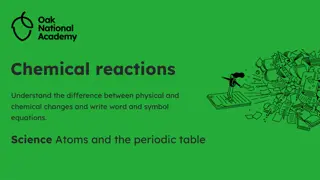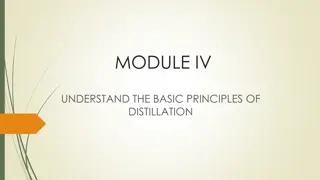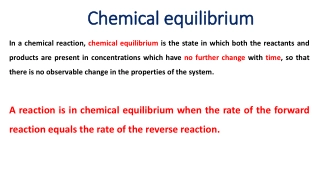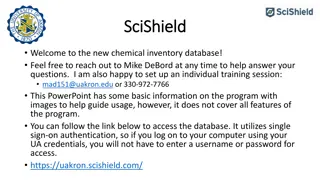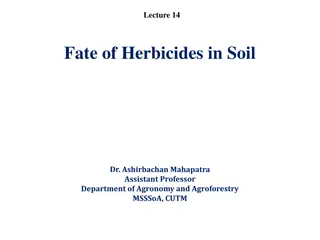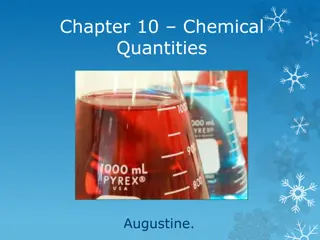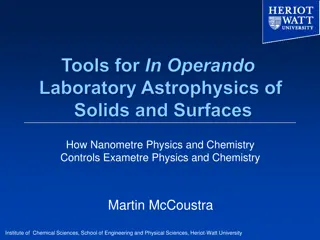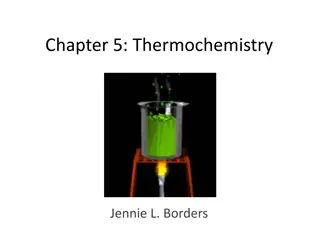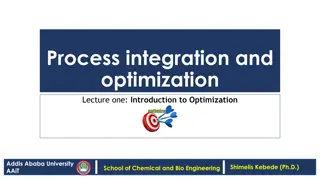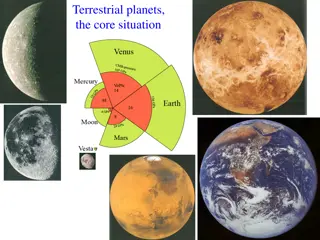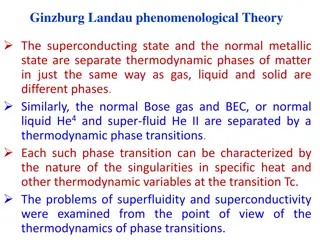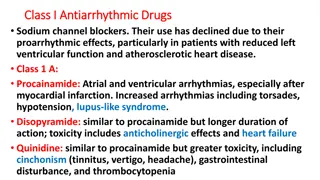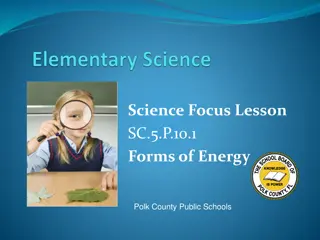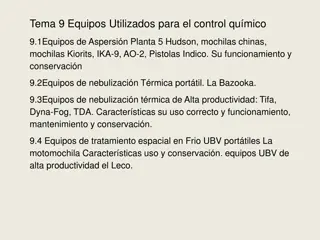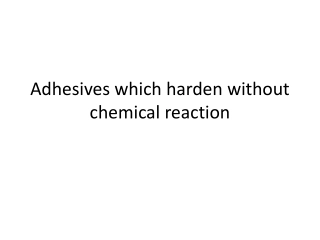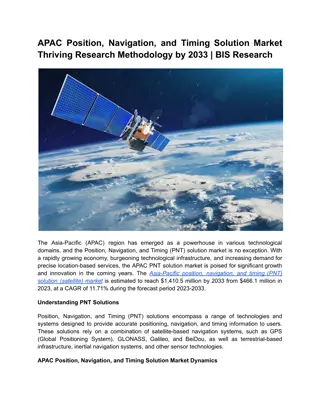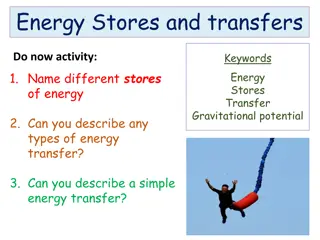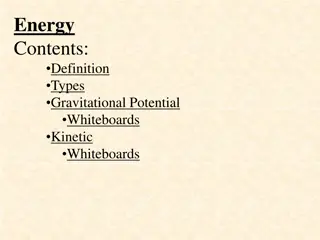Understanding Chemical Potential and Phase Equilibria in Solution Thermodynamics
The chemical potential and phase equilibria in solution thermodynamics are crucial concepts for understanding the behavior of mixtures at varying compositions and conditions. By investigating the fundamental property relation, partial molar properties, and the role of Gibbs energy, we can grasp how species interact in a system and achieve equilibrium. The concept of chemical potential plays a central role in determining phase equilibria in closed systems at constant temperature and pressure, highlighting the importance of balancing mass transfer between phases.
Understanding Chemical Potential and Phase Equilibria in Solution Thermodynamics
PowerPoint presentation about 'Understanding Chemical Potential and Phase Equilibria in Solution Thermodynamics'. This presentation describes the topic on The chemical potential and phase equilibria in solution thermodynamics are crucial concepts for understanding the behavior of mixtures at varying compositions and conditions. By investigating the fundamental property relation, partial molar properties, and the role of Gibbs energy, we can grasp how species interact in a system and achieve equilibrium. The concept of chemical potential plays a central role in determining phase equilibria in closed systems at constant temperature and pressure, highlighting the importance of balancing mass transfer between phases.. Download this presentation absolutely free.
Presentation Transcript
CHAPTER FOUR THERMODYNAMICS OF SOLUTION THE CHEMICAL POTENTIAL AND PHASE EQUILIBRIA PARTIAL MOLAR PROPERTIES IDEAL-GAS MIXTURES FUGACITY OF A PURE SUBSTANCE FUGACITY OF A COMPONENT IN A MIXTURE
FUNDAMENTAL PROPERTY RELATION The fundamental property relation for homogenous solution of variable composition is: Gibbs equation - @ equilibrium - Closed system - single component ?(??) = (??)?? + (??)?? Consider now the more general case of a single-phase, multi component that can interchange matter with its surroundings. The total Gibbs energy nG is still a function of T and P. Since material may be taken from or added to the system, nG is now also a function of the numbers of moles of the chemical species present. Thus, nG = g(T, P, ?1, ?2 ?? ..) where ?? is the number of moles of species i. The total differential of nG is: ?(??) ?? ?(??) ?? ?(??) ??? ?,???+ ? ? ?? = ?,??? + ?,?,????? .. (1) ?: Chemical Potential (nV) -(nS)
FUNDAMENTAL PROPERTY RELATION COND... Chemical potential is an intensive thermodynamics property related to flow of matter. ? n? ?ni ...............................(2) i= P,T,nj ? ?? = ?? ?? (??)??+ ? ???? (3) For the special case of one mole of solution, n = 1 and ni = ??: dG = VdP SdT + 1 ?dni .. (4) Implicit in this equation is the functional relationship of the molar Gibbs energy to its canonical variables, T, P, and {xi} at a constant-composition solution: G=G(T, P, ?1,?2, ,??, .) ?G ?TP,?V = Whenever the Gibbs energy is expressed as a function of its canonical variables, it plays the role of a generating function, providing the means for calculation of all other thermodynamic properties by simple mathematical operations (differentiation and elementary algebra), and implicitly represents complete property information. ?G ?PT,? S =
THE CHEMICAL POTENTIAL AND PHASE EQUILIBRIA Consider a closed system consisting of two phases ( and ) in equilibrium at constant T and P. Within this closed system, each individual phase is an open system, free to transfer mass to the other. Total Gibbs energy for two phases can be written: = dni ?? = (??) +(??) @eqm dni + i i dni ?(??) = i i?dni ?(??)= i i i dni @eqm ? ?? = 0 are independent and arbitrary, the only way the left side of this equation can in general be zero is for each term in parentheses separately to be zero. Hence, i = i The result for n phases is: i = i = = i Thus, multiple phases at the same T and P are in equilibrium when the chemical potential of each species is the same in all phases. Since the dni (i = 1,2, .N) (i = 1,2, .N)
PARTIAL PROPERTY The definition of the chemical potential by Eqn.(2) as the mole-number derivative of nG suggests that other derivatives of this kind should prove useful in solution thermodynamics. ? ?M ?ni Mi= (5) P,T,nj This equation defines the partial molar property of species i in solution, where the generic symbol Mimay stand for - the partial molar internal energy Ui - the partial molar enthalpy Hi, - the partial molar entropy Si, - the partial molar Gibbs energy Gi, etc. It is a response function, representing the change of total property nM due to addition at constant T and P of a differential amount of species i to a finite amount of solution. Therefore, the chemical potential and the partial molar Gibbs energy are identical; i.e., i= Gi
EQUATIONS RELATING MOLAR AND PARTIAL MOLAR PROPERTIES The definition of a partial molar property provides the means for calculation of partial properties from solution-property data. The derivation of this equation starts with the observation that the thermodynamic properties of a homogeneous phase are functions of temperature, pressure, and the numbers of moles of the individual species which comprise the phase. Thus for thermodynamic property M: nM = M(T,P,n1,n2, ,ni, ) The total differential of nM is: ? n? ?? ? n? ?? ? n? ?ni d n? = dP + dT + dni . (6) T,n P,n P,T,nj i
EQUATIONS RELATING MOLAR AND PARTIAL MOLAR PROPERTIES COND Because the first two partial derivatives on the right are evaluated at constant n and because the partial derivative of the last term is given by Eqn. (5), this equation has the simpler form: ?? ?? T,xdP + n ?? ?? P,xdT + i Midni (7) d n? = n where subscript x denotes differentiation at constant composition. since ni = xin, dni= xidn + ndxi when dni is replaced by this expression, and d(nM) is replaced by the identity: d n? = ndM + Mdn Equation (7) becomes ?? ?? ?? ?? Mi(xidn + ndxi) ndM + Mdn = n dP + n dT + T,x P,x i
EQUATIONS RELATING MOLAR AND PARTIAL MOLAR PROPERTIES COND The terms containing n are collected and separated from those containing dn to yield: ?? ?? ?? ?? Midxin + M xi Midn = 0 d? d? d? T,x P,x i i Thus, n and dn are independent and arbitrary. The only way that the left side of this equation can then, in general, be zero is for each term in brackets to be zero. Therefore, ?? ?? ?? ?? Midxi 8 xi Mi (9) d? = d? + d? + and M = T,x P,x i i Multiplication of Eqn. (9) by n yields the alternative expression: ni Mi (10) nM = i Equations (9) and (10) are known as summability relations, they allow calculation of mixture properties from partial properties, playing a role opposite to that of Eqn. (5), which provides for the calculation of partial properties from mixture properties.
GIBBS/DUHEM EQUATION Since Eqn. (9) is a general expression for M, differentiation yields a general expression for dM: xid Mi+ Midxi (11) dM = i i Subtracting Eqn. (11) from Eqn. (8), we can get: ?? ?? ?? ?? xid Mi= 0 ?????/????? ???????? dP + d? T,x P,x i xid Mi= 0 constant T and P (12) i The three kinds of properties used in solution thermodynamics are represented by: Solution properties M for example: U, H, S, G for example: Ui, Hi, Si, ?i for example: Ui, Hi, Si, Gi Mi Mi Partial properties Pure-species properties
PARTIAL PROPERTIES IN BINARY SOLUTIONS Written for a binary solution, the summability relation, Eqn. (9), becomes: M = x1 M1+ x2 M2 (13) Differentiating Eqn. (13) yields: dM = x1d M1+ M1dx1+ x2d M2+ M2dx2 (14) From Gibbs/Duhem equation {Eqn. (12)}, expressed here as: x1d M1+ x2d M2= 0 Since x1+ x2= 1 , it follows that dx1= dx2. Therefore, Eqn. (14) becomes: dM dx1 dM = M1dx1 M2dx1 or = M1 M2 (15) Elimination first of M2 and then of M1 from Eqns. (13) and (15) yields: d? dx1 d? dx1 M1= M + x2 M2= ? x1
EXAMPLE 4.1. The enthalpy of a binary liquid system of species 1 and 2 at fixed T and P is represented by the equation: H = 400x1+ 600x2+ x1x240x1+ 20x2 Determine expression for H1 and H2 as function of x1, numerical values for the pure-species enthalpies H1 and H2, and numerical values for the partial enthalpies at infinite dilution H1 Given: H = 400x1+ 600x2+ x1x240x1+ 20x2 (?) Required: H1, H2,H1 ,H2, H1 Solution: x1+x2= 1 H is in J/mol and H2 . and H2 =? Answers: Answers: H1= 420 60?12+ 40?13 H2= 600 + 40?13 H1 = 400J/mol H2 = 600J/mol H1 H2 d? dx1 d? dx1 (B) H1= H + x2 H2= ? x1 H1 @ x1= 1 H1 H2 @ x1= 0 using Eqn. (A) = 420J/mol = 640J/mol @ x1= 0 H2 @ x1= 1 using Eqn. (B)
IDEAL-GAS MIXTURES If n moles of an ideal-gas mixture occupy a total volume Vt at temperature T, the pressure is: P =nRT If the ni moles of species i in this mixture : pi=niRT Vt Vt The partial molar volume of species i in an ideal-gas mixture is found, superscript ig denoting an ideal-gas value: ? nVig ?ni ? nRT/P ?ni =RT ?n ?ni =RT ig= Vi = P P P,T,nj P,T,nj nj ? = ??+ ?? ig= Vi ig ..(16) Vi Gibbs's theorem states that: A partial molar property (other than volume) of a constituent species in an ideal-gas mixture is equal to the corresponding molar property of the species as a pure ideal gas at the mixture temperature but at a pressure equal to its partial pressure in the mixture. ig Vi igby the equation: This is expressed mathematically for generic partial property Mi igT,P = Mi ig(T,pi) . (17) Mi
IDEAL-GAS MIXTURES COND Eqs. (6.24) (J. M. Smith page 191) d?ig= CPigdT From above Eqn. the entropy of an ideal gas does depend on pressure: ig= RdlnP Integration from pito P gives: igT,Pi = R lnp Eqs. (6.23) (J. M. Smith page 191) T RdP ig= ?? ???? (6.23) dHi P (6.24) Since the enthalpy of an ideal gas is independent of pressure: igT,Pi = Hi Hi Hi igT,P Hi thus; dSi (constant T) igT,P = Hi ig= Hi igT,P p ig .(18) igT,P Si Applying the summability relation: Si = R ln yip= Rln yi Pi igT,Pi = Si ig= Si igT,P R ln yi ig R ln yi (19) Si Si Applying the summability relation: ig Hig= yiHi i 1 yi ig= 0 ig= ? Hig yiHi Sig yiSi yiln i i For ideal gases, this entropy change of mixing is always positive, in agreement with the second law. For ideal gases, this enthalpy change of mixing is zero.
IDEAL-GAS MIXTURES COND For the Gibbs energy of an ideal-gas mixture, Gig= Hig TSig the parallel relation for partial properties is: Integration at constant T gives: ig= iT + RT lnP .(21) Where i(T) , the integration constant at constant T, is a function of temperature only. Gi ig= Hi ig T Si ig Gi Equation (20) may therefore be written: In combination with Eqs. (18) and (19) this becomes: ig= Gi ig= iT + RTlnyiP (22) i ig= Hi ig= Gi ig TSi ig+ RT ln yi .(20) ig+ RT ln yi Gi Applying the summability relation: ig= Gi i ig= iT + RT lnyiP Gi At constant T for an ideal gas becomes: ig= igdP =RT Gi yi iT + RT yilnyiP ig= Vi ?Gi PdP i i
FUGACITY OF A PURE SUBSTANCE Fugacity is measure of the tendency of a gas to escape or expand. It is the pressure value needed at a given temperature to make the properties of a non ideal gas satisfy the equation for an ideal gas. Fugacity is the equivalent of pressure if you are dealing with a real gas in comparison to pressure itself which is defined using an ideal gas. Fugacity is the change in pressure required to make a real gas behave like an ideal gas. If you have some gas at 100atm with a fugacity of 97.5atm, this means that a real world gas at 100atm has the same reactivity of an ideal gas at 97.5atm. For a real fluid, the analogous equation is: Gi= iT + RT lnfi ..(23) In which pressure P is replaced by a new property fi with units of pressure. This equation provides a partial definition of??, the fugacity of pure species i.
FUGACITY OF A PURE SUBSTANCE COND Subtraction of eqn. (21) from eqn. (23), both written for the same T and P, gives: ig= RT lnfi Gi Gi P ig is the residual Gibbs energy, ?? ?. From the definition: Gi Gi The dimensionless ratio ??/?is another new property, the fugacity coefficient, given the symbol ??. Thus, Gi The definition of fugacity is completed by setting the ideal-gas-state fugacity of pure species i equal to its pressure: ?? Thus for the special case of an ideal gas, Gi The identification of ln iwith ?i rewritten: ln i= 0 Where: i=fi R= RTln i (24) P ??= ? R= 0; i= 1, and Eqn. (21) is recovered from Eq. (23). R/RT Eqn. (24) allows eqn. (6.46) (J. M. Smith page 198) to be P(Zi 1)dP (constant T) (25) P To calculate the fugacity of a pure, non-ideal gas, all we need is information on the relationship of Z as a function of P at T by equation from PVT data or from a volume-explicit equation of state.
METHODS TO GET FOR A PURE GAS Methods Equation = ( o)( 1) Reference o and 1 @ Appendix E (Table E.13 - E.16) Pr and Tr and @ Appendix B (Table B.1) Pr and Tr and @ Appendix B (Table B.1) Page Lee-Kesler Correlation 658 632 Virial Equation 632 P o 1 = + r ln B ( B ) T r . 422 . 0 T = o 0 083 B 1 r 6 . 172 . 0 T = 1 139 . 0 B 4 2 . r Vander Waals equation RT a = P ( ) 2 v b v 2 v b a Pv = + ln ln ln v b v b vRT RT RT a Redlich-Kwong equation = P 1 + ( ) v b ( ) T v v b 2
EXAMPLE 4.2 Estimate the fugacity of methane at 32 and 9.28 bar. Use the Lee-Kesler correlation approach. Given: ? = 32 = 305.15? ??? ? = 9.28 bar Required: ? =? Solution: i=fi = ( O)( 1) For methane ??= 190.6?,??= 45.99 ??? ??? ? = 0.012 (Table B.1) P ? = ? ??=? =305.15 190.6= 1.6 ??=? 9.28 45.99= 0.2 = ?? ?? 1= 1.0163 (Table E.13 and E.14) Then = ( O)( 1)?= (1.0024)0.012= 1.00 ? = ? = 9.28 bar = 0.9863
FUGACITY OF PURE LIQUID The fugacity of pure species i as a compressed liquid is calculated in two steps: First, the fugacity coefficient of saturated vapor i (25), evaluated at P = Pisat. Then fi saturated liquid at the system temperature. Second is the calculation of the fugacity change resulting from the pressure increase, pi the state from saturated liquid to compressed liquid. For the second step, an isothermal change of pressure, Eq. (26) is integrated to give: dG = VDP SdT (26) sat= i sat, and this is the fugacity of both saturated vapor and v: is determined from an integrated form of eq. sat = i satPi satto p, that changes P sat= Gi Gi VidP (A) sat Pi Another expression for the difference on the left side is obtained by writing eqn. (23) twice, for both Giand ?i Gi= iT + RT lnfi fi fi sat. sat= iT + RT lnfi sat and Gi sat= RTln Subtraction yields: Gi Gi sat (B)
FUGACITY OF PURE LIQUID COND sat are equal to: The two expressions (A) and (B) for Gi Gi p fi sat= 1 ln RT Vidp fi sat Pi Since Vi, the liquid-phase molar volume, is a very weak function of P at temperatures well below Tc , an excellent approximation is often obtained when Vi is assumed constant at the value for saturated liquid, Vl: sat) sat=V?(P Pi fi ln RT fi sat = i satPi sat and solving for fi gives: sat expV?(P Pi Substituting fi sat) satPi fi= i (27) RT The exponential is known as a pointing factor. Example 11.5 (J. M. Smith page 371)
FUGACITY AND FUGACITY COEFFICIENT: SPECIES IN SOLUTION The definition of the fugacity of a species in solution is parallel to the definition of the pure species fugacity. For species i in a mixture of real gases or in a solution of liquids, the equation analogous to eq. (22), the ideal-gas expression, is: Gi= i= iT + RTln fi (28) Where fiis the fugacity of species i in solution, replacing the partial pressure yiP. ( i = i = = i ) is the fundamental criterion for phase equilibrium. since all phases in equilibrium are at the same temperature, an alternative and equally general criterion follows immediately from eq. (28): fi = = fi = fi (i = 1,2, ,N) Thus, multiple phases at the same T and P are in equilibrium when the fugacity of each constituent species is the same in all phases.
FUGACITY COEFFICIENT: SPECIES IN SOLUTION For the partial residual Gibbs energy: ig Gi R= Gi Gi ig= iT + RTlnyiP i= iT + RTln fi i and fi yiP ig= ??ln i i R= RTln ?i Gi fi yiP Where by definition: i= The dimensionless ratio ??is called the fugacity coefficient of species i in solution. Although most commonly applied to gases, the fugacity coefficient may also be used for liquids, and in this case mole fraction yiis replaced by xi. ig= 1 and fi ig= yiP Ris necessarily zero; therefore i For an ideal gas, Gi Thus the fugacity of species i in an ideal-gas mixture is equal to its partial pressure.
IDEAL SOLUTION Another useful model is the ideal solution, which serves as a standard to which real- solution behavior can be compared. Equation (20) establishes the behavior of species i in an ideal-gas mixture: ig= Gi ig+ RT ln yi .(20) Gi We therefore define an ideal solution as one for which: i?= Gi i?+ RT ln xi (29) Gi where superscript id denotes an ideal-solution property. Mole fraction is here represented by??to reflect the fact that application is most often to liquids. The summability relation, Eq. (9), applied to the special case of an ideal solution is written: ?? (30) xi Mi ???= i
ASSIGNMENT ON CHAPTER 5 Group No. Title Page 1 13.1 The Reaction Coordinate 13.2 Application of Equilibrium Criteria to Chemical Reactions 13.3 The Standard Gibbs-Energy Change and the Equilibrium Constant 451 455 456 2 3 13.4 Effect of Temperature on the Equilibrium Constant (until eqn. 13.18) 458 13.6 Relation of Equilibrium Constants to Composition 4 Gas-Phase Reactions 464 5 Liquid-Phase Reactions 466 6 13.7 Equilibrium Conversions for Single Reactions Single-Phase Reactions Reactions in Heterogeneous Systems 13.9 Multi-reaction Equilibria 468 7 484







